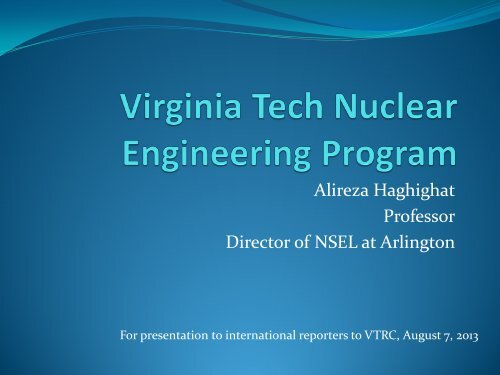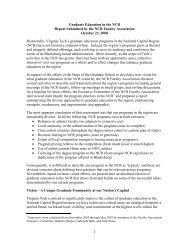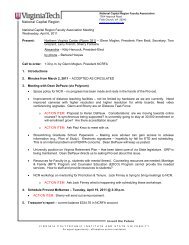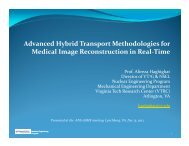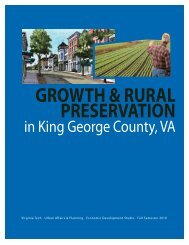Virginia Tech Nuclear Engineering Program , VT-NEP
Virginia Tech Nuclear Engineering Program , VT-NEP
Virginia Tech Nuclear Engineering Program , VT-NEP
- No tags were found...
Create successful ePaper yourself
Turn your PDF publications into a flip-book with our unique Google optimized e-Paper software.
Current <strong>Nuclear</strong> <strong>Engineering</strong> <strong>Program</strong> (2)• Faculty:• 5 Core <strong>Nuclear</strong> <strong>Engineering</strong>• 8 affiliate from other departments at <strong>VT</strong>• 1 Adjunct from Northrop Grumman• Authorized to hire two more Core faculty• Degree offering:• MS & PhD in <strong>Nuclear</strong> <strong>Engineering</strong> (starting Fall 2013)• Graduate Certificates in <strong>Nuclear</strong> <strong>Engineering</strong> for non nuclear engineers (Since 2010)• Research:• Initiated activities in all areas of application of <strong>Nuclear</strong> Science <strong>Engineering</strong>including:<strong>Nuclear</strong> Power, <strong>Nuclear</strong> Nonproliferation,Radiation therapy and diagnostics & <strong>Nuclear</strong> Policy6
<strong>Virginia</strong> <strong>Tech</strong> <strong>Nuclear</strong> <strong>Engineering</strong> <strong>Program</strong> , <strong>VT</strong>-<strong>NEP</strong>(multidisciplinary, distance learning)NSEL @ <strong>VT</strong>RC, Arlington<strong>Nuclear</strong> Science and <strong>Engineering</strong> Lab (NSEL) – Institute ofCritical <strong>Tech</strong>nology and Applied Science (ICTAS)<strong>NEP</strong> @ <strong>VT</strong>, Blacksburg<strong>Nuclear</strong> <strong>Engineering</strong> <strong>Program</strong> (<strong>NEP</strong>),Mechanical <strong>Engineering</strong> DepartmentCollege of <strong>Engineering</strong>College of ScienceCollege of Veterinary-MedicineCollege of Arts and Human SciencesVNEC-<strong>Virginia</strong><strong>Nuclear</strong> EnergyConsortium, 2013• Government agencies• Industry• Medical centers• National Capital Region (NRC)universities engaged in nuclearpolicyCAER @ LynchburgCenter for Advanced <strong>Engineering</strong> Research (CAER) – A partnershipof State of VA, industry and UniversitiesAREVAB&WLiberty, UVA, VCU, <strong>VT</strong>8
• A consortium of universities has establishedSUNRISE non-profit organization in 2007; itincludes:• 11 universities, 4 vendors, 2 non-profit organizations, andMOUs with ORNL and SRNL
Other events• Conducted the 13 th International Workshop on ParticleTransport Simulation of <strong>Nuclear</strong> Systems(http://www.cpe.vt.edu/transport) (See attachment #4for an announcement).• Organized the Forum on <strong>Nuclear</strong> Regimes: FutureOutlook (http://www.ictas.vt.edu/nuclear) (seeattachment #6 for an announcement) .17
Other activities• Profs. Kulkarni and Haghighat with help from <strong>VT</strong>’s Department Scienceand <strong>Tech</strong>nology in Society & School of Public and International Affairs(SPIA) has initiated discussions on establishment of a jointCenter for <strong>Nuclear</strong> Safety, Safeguards, and Securityin partnership with George Washington’s Elliot School ofInternational Affairs and other National Capital Region (NCR)universities.• In collaboration with other <strong>VT</strong> faculty, exploring establishment ofcertificates in <strong>Nuclear</strong> Nonproliferation & <strong>Nuclear</strong> Policy• Forming alliance with government and non-government organizations• Exploring establishment of educational programs for training studentsand professionals from other countries18
y<strong>Virginia</strong> <strong>Tech</strong> Transport Theory Group (<strong>VT</strong>3G),Directed by Prof. Haghighat
• <strong>VT</strong> 3 G is engaged in development of hybrid 3-D, multiscale,parallel particle transport algorithms and codes,and their application to nuclear energy, nuclear securityand non-proliferation and radiation therapy anddiagnosis.• In the past 25 years, <strong>VT</strong> 3 G has developed numerousparticle transport methodologies and formulations.These efforts have led to the development of majorcomputer codes including:• Deterministic parallel PENTRAN and TITAN code systems• Monte Carlo A 3 MCNP and ADIES code systems withautomated variance reduction for neutral and chargedparticles, respectively.• CPXSD code system for generation of effective multigroupcross sections.
Ongoing projects• <strong>Nuclear</strong> PowerDeveloping advanced multigroup algorithms forSimulation of Advanced Reactors (Funded by DOE–Joint with Georgia <strong>Tech</strong>) (2010-2013)Neutronics modeling of mPower <strong>Nuclear</strong> Reactor(B&W) (started in 2012)Integral Inherently Safe Light Water Reactor(I 2 S-LWR) , led by Georgia <strong>Tech</strong> with participationof 7 other organizations (recently funded) (fundedby DOE IRP, $6 M, 2013-2016)
• <strong>Nuclear</strong> Nonproliferation• <strong>Nuclear</strong> safeguardsDeveloped the INSPCT toolfor monitoring of spent fuelpool (funded by LLNL)• <strong>Nuclear</strong> SecurityDeveloped AIMS (ActiveInterrogation for MonitoringSpecial-nuclear –materials)(Funded by NNSA, Joint withGeorgia <strong>Tech</strong>, 2009-1013)Monitoring of Spent FuelPoolResponse(Calculated)(x,y) 0.5 1.5 2.5 3.5 4.5 5.5 6.5 7.5 8.50.5 0.123198 0.230998 0.221266 0.193583 0.166627 0.141523 0.114534 0.083892 0.0366111.5 0.305453 0.580498 0.561644 0.491674 0.420538 0.353999 0.28285 0.203871 0.0875992.5 0.467647 0.897903 0.880437 0.770597 0.653747 0.543993 0.427576 0.301569 0.1278193.5 0.658686 1.271323 1.252983 1.094413 0.922518 0.761393 0.591298 0.410909 0.1725544.5 0.879337 1.696988 1.669344 1.453015 1.219392 1.002015 0.772365 0.532245 0.2226165.5 1.029258 1.978009 1.923356 1.665877 1.394836 1.14574 0.880125 0.605581 0.2531926.5 0.57336 1.093457 1.058167 0.914234 0.765146 0.628852 0.482792 0.332139 0.139652Response Difference(x,y) 0.5 1.5 2.5 3.5 4.5 5.5 6.5 7.5 8.5Inspection ofContainers
•RadiationdiagnosticsSPECT Image of heartusing TITANDeveloping algorithms forimprovement of SPECTimaging and reductionradiation exposureA3) TITAN: posterior
<strong>Nuclear</strong> Power in 21 st century• Needs• Qualified workforce• R&D (e.g., enhancement of existing reactors, Usednuclear fuel reprocessing and storage, Advanced fuelcycles, Advanced reactor design in conjunction withnuclear nonproliferation considering Safety, security &Safeguards by design - 3SBD)• Effective Public information• Policy• How?• Invest in• Establishing and enhancing nuclear education & training• Building state-of-the-art facilities
Questions?


